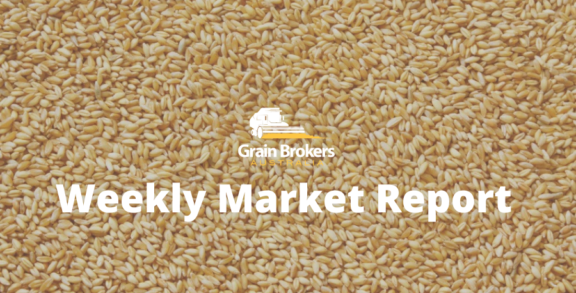
As Russia continues to target Ukraine’s grain export facilities on the Black Sea, the country’s farmers have almost concluded their 2024/25 winter and spring crop harvest campaign, with production holding up surprisingly well in the wake of an extremely dry finish that threatened to cripple crop yields.
Wheat futures in Europe and the US spiked last week after reports of a Russian missile attack on the port of Odesa rekindled concerns of grain export disruptions. The ballistic missile, launched from Russian-occupied Crimea, successfully penetrated Ukrainian air defences and struck the truck discharge bay at a foreign-owned export facility.
Fortunately, there were no employee or civilian casualties in the attack and grain stored in nearby silos, which is destined for the export market, was not damaged. Once it became clear that interruptions to the flow of exports due to the bombing would be minimal, wheat futures retreated to close the week lower than before the Russian attack.
As the winter and spring crop harvest draws to a close, the Ministry of Agrarian Policy and Food of Ukraine reported on August 16 that more than 31.9 million metric tonne of grain and oilseeds had already been reaped, made up of 28.5MMT of grain and pulses, and 3.4MMT of oilseeds. The total harvested area is just shy of 7.95 million hectares, with the wheat and barley harvests finished and the rapeseed and pulse harvests both 99 per cent threshed.
Total wheat production for the 2024/25 season finished at 21.7MMT off 4.85Mha for an average yield of 4.47 metric tonne per hectare. This compares to last year’s harvest, which saw 22.97MMT harvested off 5 million hectares for an average yield just 2.6 per cent higher at 4.59MH/ha. The official agriculture ministry numbers differ slightly from those reported by the USDA. In last week’s global supply and demand update, the USDA pegged wheat production slightly lower at 21.6MMT, but the harvested area was higher at 5.2Mha, giving an average yield of only 4.15MT/ha.
Barley production came in at 5.5MMT off a harvested area of 1.4Mha and an average yield across the country of 3.93MT/ha. In the 2023/24 season, total barley output finished at 6.11MMT off 1.68Mha for an average yield of 3.64MT/ha, 7.4 per cent lower than this season’s effort. The USDA has this season’s barley production, area and yield at 5.3MMT, 1.5Mha and 3.53MT/ha, respectively.
Rapeseed is the primary winter grown oilseed in Ukraine, and with the final harvest tonnes still trickling into storage facilities, the harvest currently stands at 3.4MMT off a harvested area of 1.23Mha. That compares to the final output from the 2023 harvest of around 4.75MMT off 1.6Mha. This season’s average yield of 2.76MT/ha is 7.1 per cent lower than the 2023 average of 2.97MT/ha.
The main winter pulse crop grown in Ukraine is yellow peas, and according to the agriculture ministry, output from this year’s harvest currently sits at almost 460,000 metric tonne. This is off a harvested area of nearly 208,000 hectares for an average yield of 2.21MT/ha.
On the export front, Ukraine’s Prime Minster Denys Shmyhal stated at a government meeting last Friday that more than 2,300 ships entered Ukrainian ports on the Black Sea in the 12 months since the Black Sea Grain Initiative ended and the Ukrainian Maritime Grain Corridor commenced operation. The export volume in that period was more than 64MMT, with grains and oilseeds shipments of around 44MMT making up around 69 per cent of the total.
According to the USDA, Ukrainian wheat exports in the 2023/24 marketing year, which concluded at the end of June, totalled 18.4MMT, thanks to a drawdown in stocks of more than 2.1mmt. Domestic consumption of around 7.5MMT in 2023/24 was also down around 0.7MMT compared to the previous year, adding to the exportable surplus. With a bare-bones carry-in of less than 0.8MMT and an expected jump in domestic consumption to 8.5MMT, the USDA’s August update put 2024/25 wheat exports at 14MMT, up from 13MMT a month earlier, but 21.7 per cent lower season-on-season.
Wheat exports to the EU and Egypt, traditionally major destinations, grew by 12 per cent and 260 per cent, respectively, and Pakistan became a new destination, importing 814,000MT. There was also a spike, collectively totalling around 2.5MMT, in shipments to several smaller destinations such as Vietnam, Algeria, Lebanon, Israel, Tunisia, and South Korea. This volume expansion became possible due to a significant drop in exports to Türkiye, down from 3.1MMT to 1.1MMT.
Exports of barley in 2023/24 totalled 2.3MMT, down from 2.56MMT the previous season, with ending stocks unchanged. Exports to China rebounded to 29 per cent of total shipments, up from 10 per cent in 2022/23, Saudi Arabia, a traditional pre-war market, was back on the buyers list, but consignments to the EU fell. Domestic consumption increased slightly to 3.5MMT, with around 1MMT going into food, seed and industrial uses, predominantly malt for the brewing and distilling industries, and 2.5MMT going into stockfeed rations.
Ukraine’s rapeseed exports in 2023/24 totalled around 3.7MMT, with traditional European Union customers the leading destination. Shipments to the EU increased by around 6 per cent to just under 3.2MMT, making it the trading bloc’s leading supplier of the oilseed. An increase in Ukraine’s domestic crush saw it exceed 1MMT for the first time in 2023/24, leading to record rapeseed oil exports of 420,000MT for the season. As a result, Ukrainian rapeseed oil is gaining a firm foothold across the EU and in key Asian markets such as China, Malaysia and Singapore.
Grain and oilseed exports in July, the first month of the 2024/25 marketing year, were 4.2MMT, more than double the same period last year. This included 3.7MMT through Odesa and 570,000 via Danube River ports, with China, Egypt and Turkey the key destinations. The surge came despite the recent intensification of Russian attacks, very similar to that of last week, on the key Black Sea export hub of Odesa and the main Danube River port of Izmail.
The export tempo has continued in the first half of this month, with 1.56MMT shipped to August 14 against 848,000 metric tonne in the same period last year. Rapeseed exports for the first two weeks of the month were 420,000, already exceeding total July shipments of 411,000MT. This compares to 670,000MT for the entire month of August 2023 and puts Ukraine on track for a new record high if the current pace is maintained.
Call your local Grain Brokers Australia representative on 1300 946 544 to discuss your grain marketing needs.
Written by Peter McMeekin.





